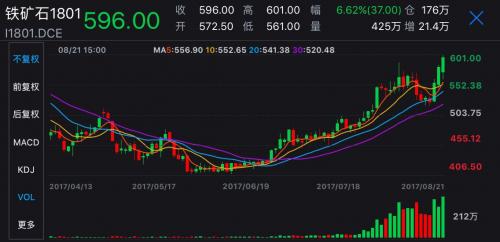As the US awaits its first full solar eclipse since 1918, S&P 500 futures, together with Asian and European stocks started off the week off fractionally in the red after the cash index fell to its lowest level in five weeks on Friday, with the “Bannon rally” fading on growing concerns about the US political situation, while tensions ratcheted up again as the US and South Korea began massive military drills and North Korea responded, threatening a “merciless strike†on the US. Markets are looking ahead to this week’s Jackson Hole symposium where Mario Draghi may or may not pre-announce the start of ECB balance sheet tapering.
With overnight markets doing little of note, a quick preview of today’s main event: the full solar eclipse which is the first such event to cross the contiguous United States since 1918. Of the main financial centres there will be a partial eclipse in New York (c70%), Boston (c63%), Chicago (c86%) and LA (c61%). To celebrate, Royal Caribbean’s week long “total-eclipse” cruise offers passengers get the best opportunity to see the event at sea, while Bonnie Tyler has been hired to perform her 1983 classic “Total Eclipse of the Heart” while the skies darken.
Meanwhile, as the US waits to fade to darkness, world stocks struggled at a five and a half week low on Monday, though metals surged in Chinese trading with zinc at its highest in a decade, copper hitting a nearly three-year high and iron ore’s gains in the last two sessions stretching to 5 percent.
The dollar was little changed after rising from a four-month low against the yen Friday, as speculation the currency will get a boost from the Steve Bannon’s exit from the White House was offset by concern about the joint military drill in South Korea. The USD/JPY dipped in European trade, holding above a four- month low reached on Friday. Trading was muted and bids for the dollar were limited amid concerns about a new North Korean escalation/provocation/retaliation and as traders await the start of Jackson Hole, which begins Thursday.
“Arguably Bannon’s departure was more about egos than policy change, but markets seem to have opted for the hopeful narrative that it is a step away from protectionist trade policies,†said Sean Callow, a senior currency strategist at Westpac Banking Corp. in Sydney. “If so, this would reduce trade tensions and limit safe haven flows into the yen.â€
South Korea’s won led modest gains in Asian emerging-market currencies as the MSCI EM Asia Index of stocks resumed its advance. Government bonds were mixed after a rally in U.S. Treasury yields reversed. The Bloomberg Dollar Spot Index and the yen rose. Caution before the Jackson Hole symposium late in the week means that “gains in Asian emerging currencies may be opportunistic and shallow rather than driven by conviction,†said Vishnu Varathan, head of economics and strategy at Mizuho Bank in Singapore.
The Topix index slid 0.1% with volume was about 16 percent below the 30-day intraday average, while the Nikkei 225 lost 0.4% as banks and technology companies weighed on the gauges after yen’s three-day ascent against the dollar. Australia’s S&P/ASX 200 Index dropped 0.4 percent, with BlueScope Steel Ltd. tumbling as much as 23 percent after the company reported disappointing earnings. Hong Kong’s Hang Seng Index added 0.4 percent and the Shanghai Composite Index was up 0.6 percent. The MSCI Asia Pacific Index slid 0.1 percent.
European stocks fell for a third session, though M&A activity helped shipping giant Maersk jump and the rally in metals sent Rio Tinto, BHP Billiton and Anglo American higher. The Stoxx Europe 600 Index fell 0.1 percent in early European trading. The MSCI All-Country World Index declined 0.1 percent to the lowest in almost five weeks on a closing basis. Germany’s DAX Index tumbled 0.4 percent. The U.K.’s FTSE 100 Index dipped 0.2 percent. The MSCI Emerging Market Index jumped 0.2 percent.Futures on the S&P 500 Index decreased 0.1 percent to the lowest in more than five weeks.
While global stocks started the week generally on the backfoot, the same can not be said for industrial metals with zinc surging to the highest level since October 2007 at $3,180.50 a tonne, “Dr. Copper” rallied to $6,593 a tonne, its highest since November 2014, and nickel, used in stainless steel, gained over 2 percent to a 2017 peak.
Iron ore futures soared 6.6% before Dalian Commidity Exchange imposed a daily purchases and sales limit for Jan & Feb delivery to 6000 lots.

“I’m looking at the prospect for the global economy and looking at the price of metals and there seems to be a significant disconnect between the two,” said CMC markets strategist Michael Hewson. “But it’s certainly helping the mining sector, which has been beleaguered for quite some time.”
In addition to (geo)political tensions, and worries about the looming debt ceiling negotiation, Fed Chair Janet Yellen and ECB President Mario Draghi will be among the officials addressing this year’s annual conference hosted by the Kansas City Fed. The Jackson Hole summit comes as central banks in advanced economies grapple with ending years of unprecedented monetary easing, even as stubbornly tepid inflation clouds the outlook.
“The key event this week is the Jackson Hole central bank policy forum which begins on Thursday,†Citigroup strategists including Peter Goves wrote in a note to clients. “The market spotlight will likely focus on Yellen, given the generally low U.S. inflation environment and the likelihood of Fed balance sheet reduction occurring relatively soon.†As the following Bloomberg chart shows, traders are starting to hedge for potential Jackson Hole-induced volatility with one-week EURUSD implied-realized vol premium rising rapidly.

